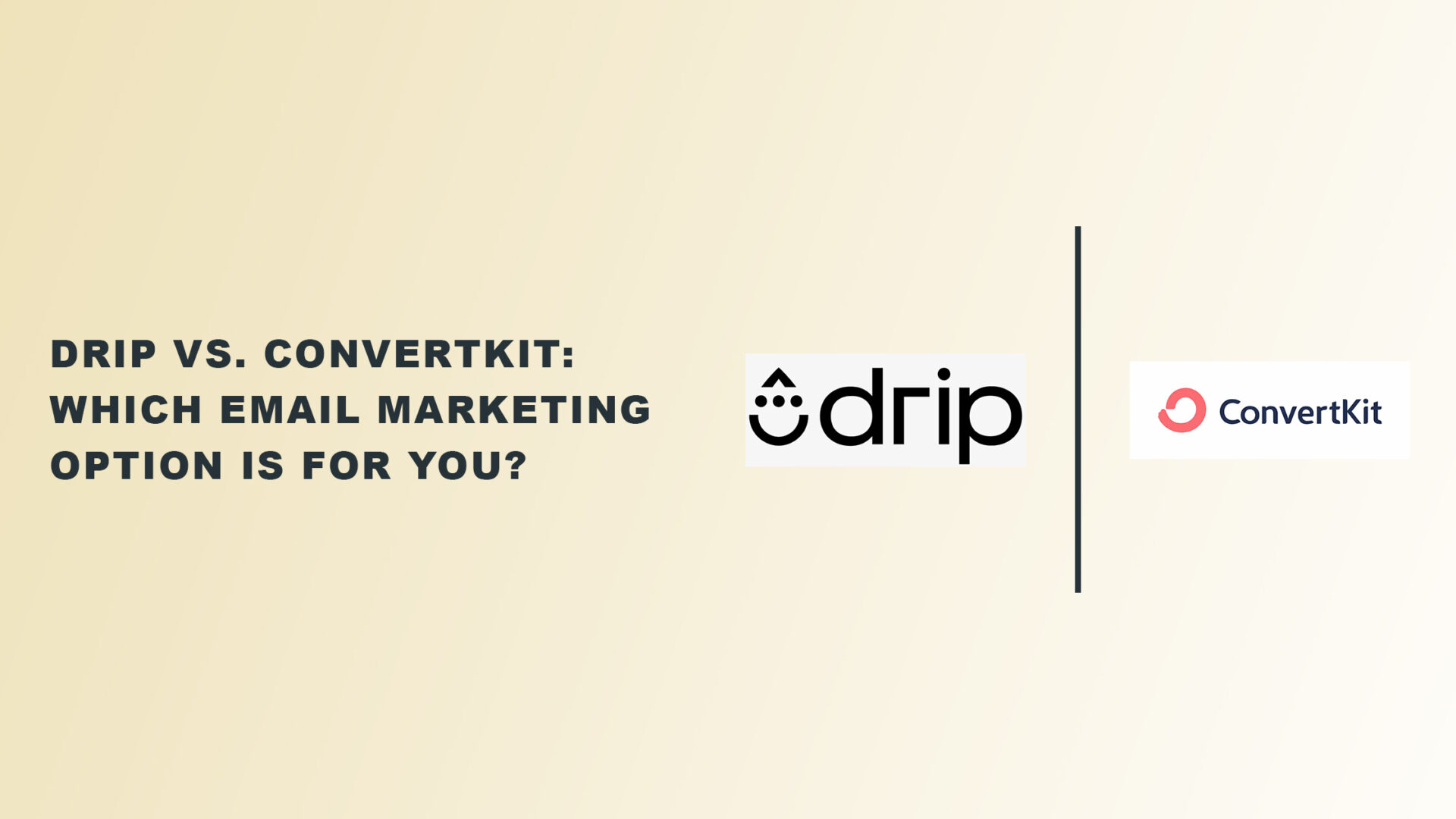Are you also confused about which one you should root for in the Drip vs. ConvertKit debate?
Since you’re reading this article, we assume you already know that email marketing is the best for building personalized customer relationships.
So, we’re not going to convince you why.
But most marketers need help finding the right email marketing service to grow their business. That’s what we’re going to help you with.
This post will provide an unbiased comparison of two popular email marketing services — Drip and ConvertKit — to help you decide which is the right choice for your email campaigns.
Drip vs. ConvertKit: A Quick Verdict
Frankly, both ConvertKit and Drip are great tools with two distinct features serving different sets of audiences.
The key is to figure out why you need it and what you want to achieve.
But to give you a quick verdict, ConvertKit is a perfect email marketing platform for Creators e.g., bloggers, influencers, and anyone who wants to keep in touch with their audience.
It’s easier, more affordable, and has a brilliant support team. We use ConvertKit for our email list and would recommend it to others.
On the other hand, Drip is suitable for eCommerce business owners. It has advanced workflow templates to help you avoid missed sales opportunities like abandoned carts.
So, if you need a tool that increases your sales through emails, you should choose Drip.
Still want to see the whole picture?
Let’s dive in.
What Is Drip?
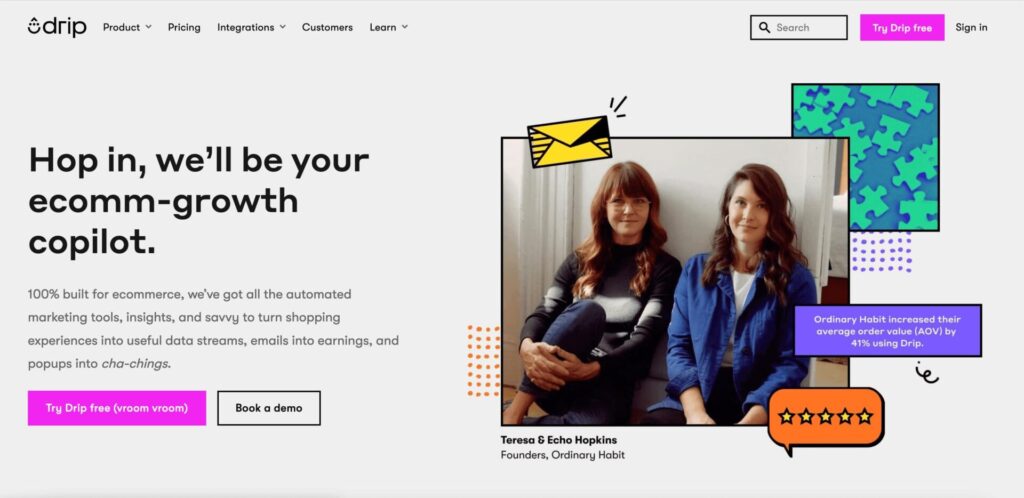
Drip is a powerful email marketing software for online business owners with eCommerce stores. Rob Walling founded Drip in 2013; in 2016, LeadPages acquired it.
Since then, Drip has been helping more than 30,000 brands increase their revenue.
Drip offers unique email features like forms, automation builder, and analytics.
The best part is that you can automate SMS workflows. People often don’t read emails but never skip SMS, so you can double your sales using Drip’s SMS automation workflows.
It’s an easy-to-use tool with a simple user interface. It has five menu items:
- People – which makes subscriber management and segmentation easier,
- Forms – where you can create forms to collect more subscribers,
- Campaigns – where you’ll manage the emails or automation sent,
- Workflows – where you’ll create workflow sequences to send to a different set of audiences, and
- Analytics – where you’ll have insights into your performance.
What we particularly liked about Drip was the “marketing playbook” in the “Campaigns” tab.
Most marketers don’t know how to set up the system and struggle to use the tool.
However, the marketing playbook is a step-by-step instructional guide that includes video tutorials to help you.
Now, let’s explore ConvertKit.
What Is ConvertKit?
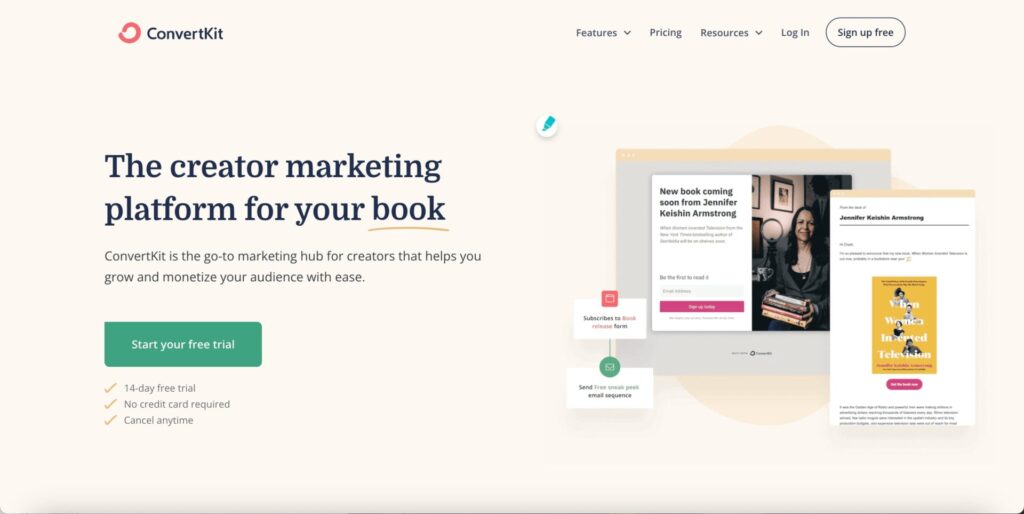
ConvertKit is the first email marketing tool explicitly created for creators and small business owners.
It’s for you if you’re a blogger, podcaster, influencer, YouTuber, writer, musician, or coach.
Nathan Barry created ConvertKit in 2014, and its growth has been magnificent.
At the time of writing this post, 428,152 creators use ConvertKit, including well-known names like Neil Patel, Pat Flynn, and Tim Ferriss.
It is famous among creators because of the features it provides.
It has a drag-and-drop landing page builder and more than 100 pretty templates. You can send broadcast emails or automate an email series.
If you don’t have a website like most creators, you can continue with ConvertKit’s free domain.
Meanwhile, if you already have one, set it using the “Custom domain” option.
Like Drip, ConvertKit’s dashboard is simple and shows you the analytics section.
It also has five menu options:
- Grow – where you manage email subscribers and landing pages,
- Send – where you manage emails,
- Automate – where you can automate your email marketing efforts,
- Earn – where you’ll manage your earnings,
- Learn – a section to help you scale your skills.
ConvertKit stands out because of its various monetization methods. With it, you can build a thriving online business.
It offers all features to sell products like eBooks and online courses and monetize individual newsletters.
The Tip Jars option allows creators to sell paid newsletters and start a membership plan.
And for beginners, ConvertKit has a blueprint that walks through the basics. However, it’s not as detailed as Drip.
Now, let’s compare both tools.
Drip vs. ConvertKit: Features Comparison
Ease of Use
Drip has a simple user interface.
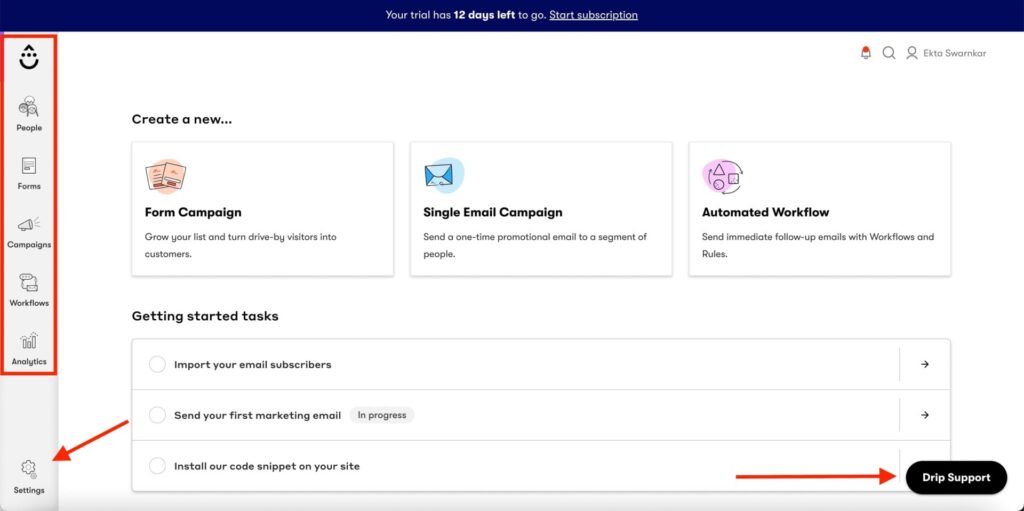
With only five menu options, it already covers everything. Also, the dashboard shows quick navigation options if you want to create emails immediately.
You can modify its settings by clicking on the “Settings” button. It also has a “Drip Support” button at the bottom right in case you need help.
On the other hand, ConvertKit’s dashboard shows the analytics section. You can find the menu option on the top bar and the quick navigation at the right sidebar.
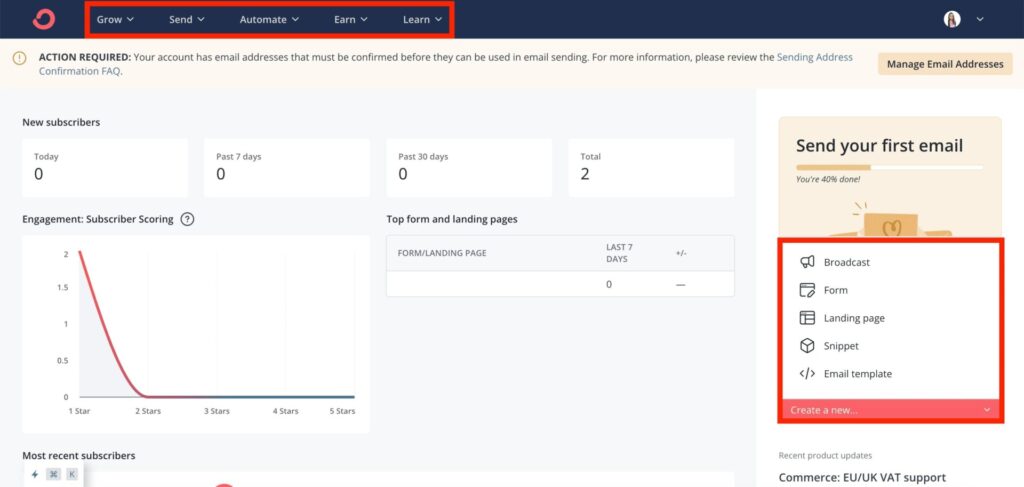
Both have a user interface that’s super easy to use. But we like Drip more. It’s quick, more intuitive, modern, and has a better design.
A/B Split Testing
When it comes to A/B split testing, Drip has better options than ConvertKit.
Drip allows you to split-test both subject lines and email content. You can set a time to collect data and send different content based on the analysis.
Compared to that, ConvertKit only allows you to split test a subject line.
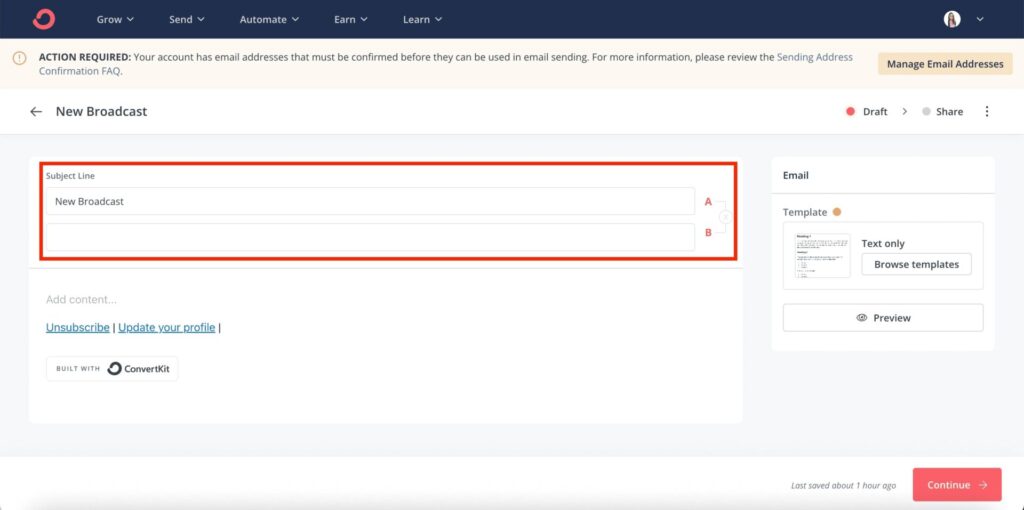
You can send conditional email content, but you need to know how to use conditional statements first.
Forms and Landing pages
Shocker! Drip does not have a builder for forms and landing pages.
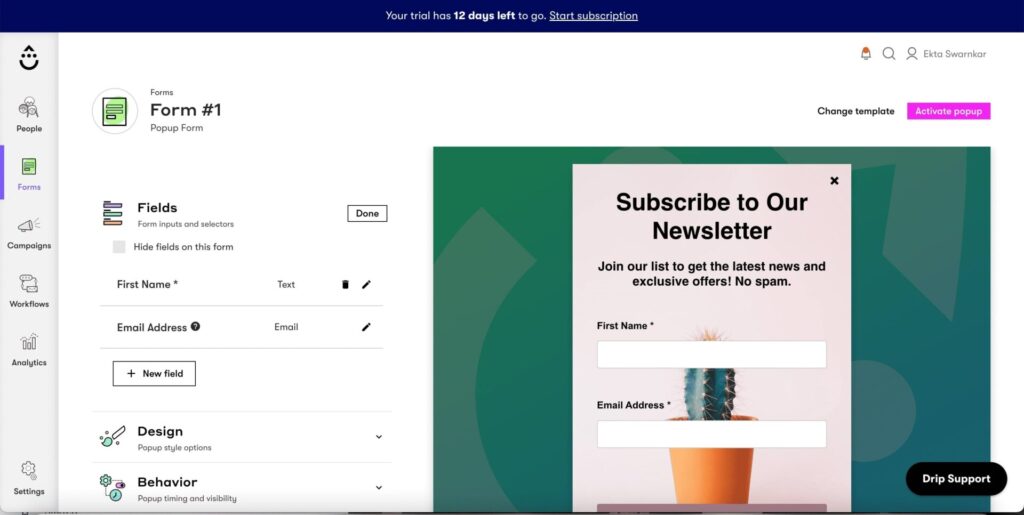
You can only design email opt-in forms to embed on your website or blog post for lead generation. It has limited templates, but you can edit each section of a Drip campaign.
Meanwhile, ConvertKit has a smart landing page editor and form builder. Aside from that, you have plenty of templates for your landing pages.
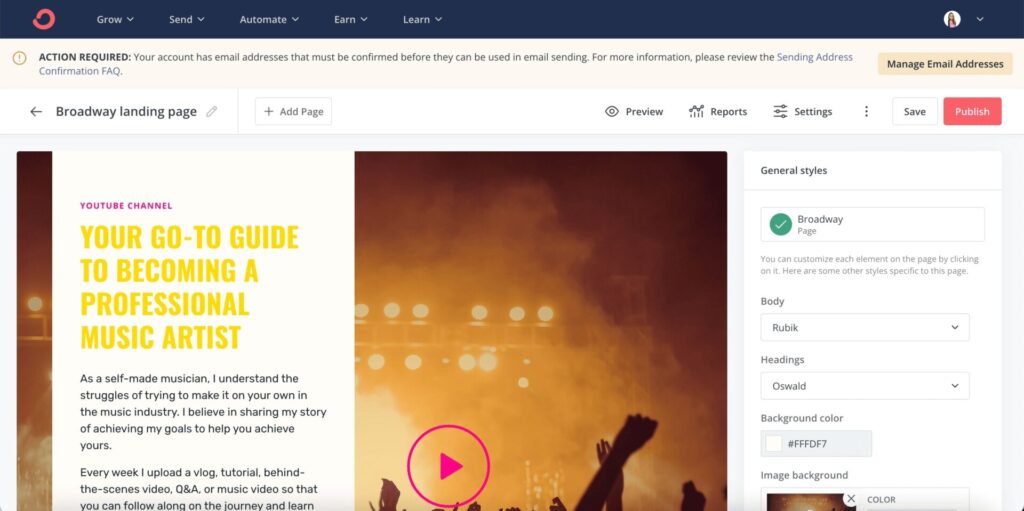
You can host these landing pages on ConvertKit’s domain – a handy feature if you don’t have a website.
It also makes adding new subscribers easy, as you can design as many landing pages and opt-in forms as you want.
Customer Support

Drip provides learning resources, including blogs and a help center. But nowhere do they mention 24/7 live chat support.
You don’t have an option for phone support either.
While you can use the standard Drip Support button on your dashboard, it’s email-based.
However, they do market themselves as having an excellent support team.
This is true because as soon as I created an account, someone greeted me through their email support to walk through the basics.
On the other hand, ConvertKit offers constant contact support through chat, phone, and help resources.

On your dashboard, you can navigate to the “Learn” section to find community support, academy, and documentation. You can also use the live chat option to ask for help immediately.
Integrations
Both Drip and ConvertKit have 100+ integrations with third-party services.
However, since Drip helps eCommerce store owners, it has more integrations with online stores.

ConvertKit only has three integrations with online stores but has many landing page integrations.

As they constantly evolve, both platforms give you the option to recommend an integration.
Email List Management
Subscriber management is similar in both tools.
Drip has a unique feature that assigns lead scoring automatically.

For example, if a subscriber shows engagement (e.g., opens, clicks, purchases), it gets a high score.
Another fantastic feature is its segmentation tool.
To send personalized emails, you can segment emails based on the subscriber’s activity, such as if they purchased five times.
In contrast, ConvertKit does not assign points to leads; instead, you’ll have to do that manually.

But you can create segments and add subscribers to different tags.
Email Marketing Automation and Broadcasts
Drip allows small businesses to send both single emails and email series.

In fact, it has the best feature: pre-built workflow templates. Just pick one, customize it, and you’re good to go.
It also has advanced automation features to create workflows. Not only that, but it’s super simple to design complex workflows.
Additionally, you can create marketing automation blueprints for abandoned carts and welcome sequences with Drip.
Meanwhile, ConvertKit lets you send both broadcasts and email sequences.

You can use hundreds of pre-built email templates to design a broadcast email and save snippets to use later.
Analytics
Drip’s analytics is more detailed. It shows advanced reporting insights like click activity and revenue.

It also lets you view subscriber data in the “People” tab. But, you must install a simple code snippet to collect site data.
On the other hand, ConvertKit offers basic reporting.

Its dashboard only shows email metrics like subscriber growth chart, and that’s pretty much it.
But, if you sell digital products, you can view the analytics under the “Earn” column.
ConvertKit vs. Drip: Pricing Comparison
Drip

The pricing starts at $39 per month for up to 2500 active subscribers. You get access to all premium features and can send unlimited emails.
It does not have a free version. However, you can get the 14-day free trial (no credit card required) if you want to try it.
Check out Drip’s pricing to learn more.
ConvertKit

ConvertKit offers three plans: free, creator, and creator pro. For established creators who want to scale their online business, the creator plan costs $25 per month.
It has a free-forever plan for up to 300 subscribers. However, you can’t use many of its features.
Check out ConvertKit to learn more about its pricing plans.
After comparing, ConvertKit is more affordable than Drip.
But, Drip offers advanced eCommerce features like automation rules, event marketing, and email sequences, so the pricing speaks for itself.
Frequently Asked Questions on Drip and ConvertKit
ConvertKit vs. Drip: which is better for beginners?
ConvertKit is a better email provider for beginner creators. It has options to integrate your eCommerce store.
But if you’re comfortable with marketing automation workflows and need an advanced email marketing platform to grow your sales, Drip is your choice.
ConvertKit vs. Drip: which offers a free plan?
ConvertKit offers a free plan for up to 300 subscribers. However, you can’t send sequence emails and use many other premium features.
Who is ConvertKit suitable for?
ConvertKit is best for creators like professional bloggers, influencers, podcasters, YouTubers, writers, and musicians.
It is a perfect option for both a beginner and an advanced marketer.
Who is Drip suitable for?
Drip is an email marketing software with advanced features for eCommerce stores. If you want to sell products using emails, choose Drip.
Final Thoughts on Drip vs. ConvertKit: Which Is a Better Email Marketing Tool?
It depends on what you want to do. If you want to build relationships and nurture your list for subscriber growth, there’s no point in paying extra for Drip’s eCommerce features.
But if you’re an advanced marketer heavily dependent on emails for sales, you might feel ConvertKit misses many essential features.
So, which tool would you go for? Have you used any of them before? Let us know what your experience was like!

